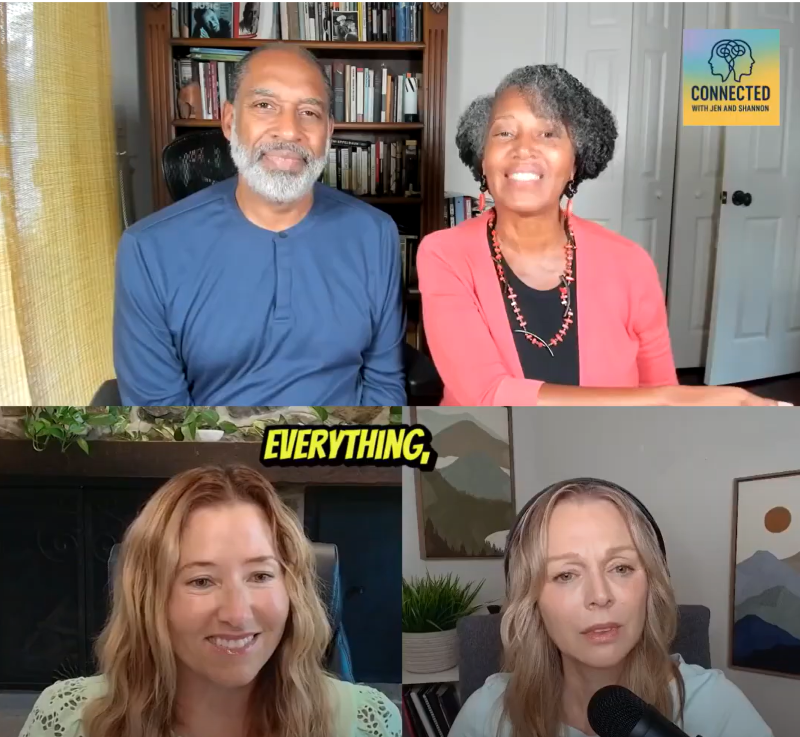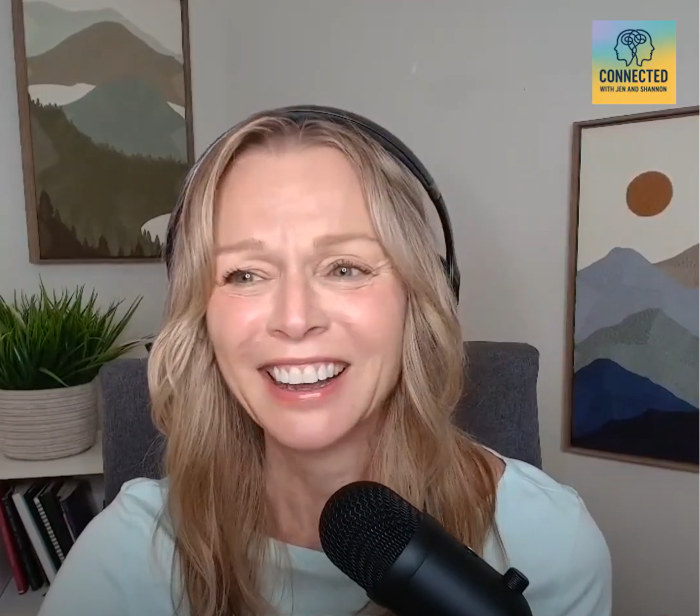Mind-Boggling Possibility via Deep Connection
Jewel and I met Shannon Nothstine and Jen Gerometta, hosts of the Connected with Jen and Shannon podcast, this past summer in California when we led a full-day workshop for the Blue Sky Leaders program of the California Institute of Integral Studies. Each participant in the program is tasked with creating a “capstone project”; the podcast became Jen and Shannon’s co-creative capstone.
Below you’ll find a short excerpt from the just-released podcast episode in which they interview us. This interview is special because it’s the first time we’ve been in a public conversation with hosts who have experienced our live workshop. The conversation, therefore, reflected the profound embodied flow that we strive for in our JLP experience with a live jazz trio.
We always begin our workshops with “Take the ‘A’ Train,” Duke Ellington’s theme song for his big band, because it symbolizes the beginning of a journey. Jen and Shannon decided to title the episode based on another Ellington classic, “It Don’t Mean a Thing (If It Ain’t Got That Swing),” which we used in their workshop as a fun call-and-response exercise. As one of our favorite interviews ever, this soulful dialogue exhibited the kind of informed and buoyant spontaneity that the practice of swingin’ represents.
Shannon Nothstine: If we have this ability to attune with each other, to resonate with each other on an idea or a song or whatever, what does that tell us about what is possible in our world today?
Jewel Kinch-Thomas: What a great question.
Greg Thomas: When we talk about translating the beauty and power that we hear in jazz into the workplace, or just in our world, we have to recognize certain things. There's going to be a diversity of points of view, of perspectives, of angles. There will be things that people don’t see eye to eye on. That's fundamental. So, the question is, how do you incorporate and integrate differences? How do you manage those differences? And then how can you leverage those differences?
Sometimes you just must agree to disagree. But sometimes, and this is where leadership comes in, you have to find a way that if you, say, have two circles of difference, are there ways of bringing those two circles together so that they intersect? That intersection point can then become a place where we can agree to work together despite differences and disagreements.
There's so much division in our society and our world [that] we need to have small pockets, small examples of what is possible.
Jen Gerometta
Jen Gerometta: Jewel, did you have something that you wanted to share?
Jewel: Yes. I would say it's the ability to step into that space and understand that there is an interconnection, there is some commonality, there is something there that takes from both perspectives and creates something new, something different, so that you're not isolating yourself in your particular leadership style.
One of our principles is Shared Leadership. The notion of shared leadership is that I'm recognizing you as a leader and respecting your thoughts, your ideas, and your approach, so that I can see the value that can bring in a particular circumstance. And once you take that perspective, it's so much easier, then, to open up the space for possibilities. What can shift here? What pivot do I need to make? Or that my colleague needs to make for us to understand that there is a way forward, that we can navigate this as two separate individuals, but into that shared purpose.
Greg: I’d like to add to that. There are two very good books on leadership that I recommend. One is called Team of Teams, and then a follow-up to that called One Mission, where they talk about the importance of an “aligned narrative.” There has to be a shared story that we buy into together that then gives a basis upon which to move and work together in spite of those differences.
In an organizational setting, you often have silos. This particular group or this particular department with a particular function. Then you have another group or department that has another function, and they're seeing things from their particular perspective. But in an aligned narrative, a shared narrative, that story provides the purpose through which you can begin to get beyond those silos and those separations.
We call our model a cultural technology, grounded in jazz, that provides a way for us to respect and honor individual contributions, but within the context of a group, of an ensemble. And in the same way [that] we do in a democratic system, you recognize the individual, but also the group dynamics, and ways of navigating it through communication, through dealing with the unexpected, with challenges and competition. All of those are integrated into this cultural technology that we base on jazz and extend out to the workplace and beyond.
Jewel: And that's what you see playing out on the bandstand. And it's one of the most beautiful things when we go into our workshops with our trio. Workshop participants observe what's happening when these musicians are playing, how they are constantly communicating with each other. And it may be verbal, or it may be a non-verbal form of communication. But they are signaling each other all the time, so that communication enables them to move forward because the music is future-oriented—that’s where they sit. How can we move the music and the musicianship to the next phase, to the next level? When people see this in person, and they’re aware of some of the things that Greg mentioned, the uncertainty, the challenge, the improvisation, the syncopation—all of it is just constantly flowing. It creates a space of possibility that is sometimes mind-boggling.
Greg: But it’s one thing for us to talk about it; it's another thing for people who have actually experienced this to riff [on it]: Jen and Shannon, if you wouldn't mind, we'd like you to share what you experienced when you saw the type of interaction that the JLP trio, the rhythm section, embodied. What was that like for you?
Shannon Nothstine
Shannon: The weekend we spent with you in California was our favorite. I remember it so clearly as the weekend that really brought our group together; there was a turning point. And I think what happened was we all realized we're resonating with each other, right? Being in the room with you all, hearing you, seeing you, how you all work together.
I think I realized that we're doing that all the time with each other, right? Jen and I always talk about how the words are so limiting. And the beauty of this, the ensemble and you all together, you don't need words to communicate. Right?
Jewel: True. We talk about Big Ears. That's what we call our practice of deep, soulful listening. And the soulful part is what you're talking about, Shannon. It's about connecting on a level that is not about necessarily verbalizing. It's about tone. It's about rhythm. It's about the feelings, the emotions.
It's all these things all wrapped up together that intuitively you feel into. You can create something new because you understand now more about where that person is, what they're trying to communicate to you, and therefore what you can create together. So soulful listening is generative, yes. It's generative in how it allows for grace. Grace for myself to be able to express, and grace for you to be able to share with me what your talent is and what your contribution is.
Jen: So, I'll share what the experience was like. Thank you, Greg, for asking. And I want to go back to what you were both saying about the story that you're telling. Shannon and I are obsessed with stories, as I'm sure you and all of our listeners know. But what I observed when I was witnessing your workshop, was watching the story unfold. And as you're mentioning, it's future-oriented and it's emergent.
So you have all of these, the members of the group, the jazz band, clearly working together to tell the same story, right? They've got the same purpose and just like you're saying they're all experts. They've all put the time in and yet what did we see, Shannon, not words, but you saw that subtle body language That's subtle shift forward, that subtle glance, that little movement of your body. The listening, as you've mentioned, to the pause and the note of when it's my turn to take a turn, when should I play faster. That was the beauty for me, the emergence of this story that hadn't been told before until that very day. I'm certain that that exact tune had never been played in that exact way except the day that we experienced it.
And that is meaning. And that is, as Shannon alluded to, a theme of John Vervaeke’s, who we just interviewed, so he's top of mind. That shared story is meaning making.
Jewel: Yes, it absolutely is. And it is, just think about that, what you said Jen, in the moment these musicians are creating the music that tells the story. And it is an expression of all members, whether it's three or ten or even a big band. We talked about this in our workshop last week in New York City for Google.
In terms of relationships, imagine if you took that type of listening to the workplace. And people are constantly aware, not only self-aware, but multi-dimensional awareness of what is happening with their colleagues. So when Greg talked about silos and the marketing department not sharing with the engineering department who's not sharing with the production department, if they realize that they are and should be telling the same story to get that product out to the public who's going to benefit from it, then they can shift how they listen to each other, how they respond to each other, and how they create together.
Greg: I want to add to that by saying this specific example that you're talking about, Jen, was an exercise called Layered Listening. Our workshop with you was the first time we did it because we wanted your group to experience the various layers of the music. It was on a song by our musical director, Corcoran Holt.
You hear the bass alone to start. And then the electric keyboard enters with a kind of floating sound. And then the drums came in. So, each time an artist came in, it added another layer. So you went from an individual to two, to three, and then to an emergence. Something even beyond just the three of them is created. Why? Because we were there, you were there, and we were experiencing it together. So, in the [co-creative] field, something very powerful [happened]. And in fact, recall that some people were actually moved to tears. It was very moving.
Shannon Nothstine:
I love this idea of layered listening. Jen and I are both communicators. And one of the things I am always teaching is that the number one skill to be a good communicator is active listening, right? It's something you can practice. It's something that really takes shape in any situation that you're in, whether it's in the boardroom, whether it's in an interview, or just in conversations, right? It's that deep listening that brings you to the next level of what's really going on, that next level of awareness, right? Or what Sanjay Manchanda says is the field, right? He calls it the field. That really resonates with us.
We’re confident that our whole conversation with Jen and Shannon will resonate with you, so we invite you to listen and/or watch at Apple Podcasts, Spotify, or YouTube.



